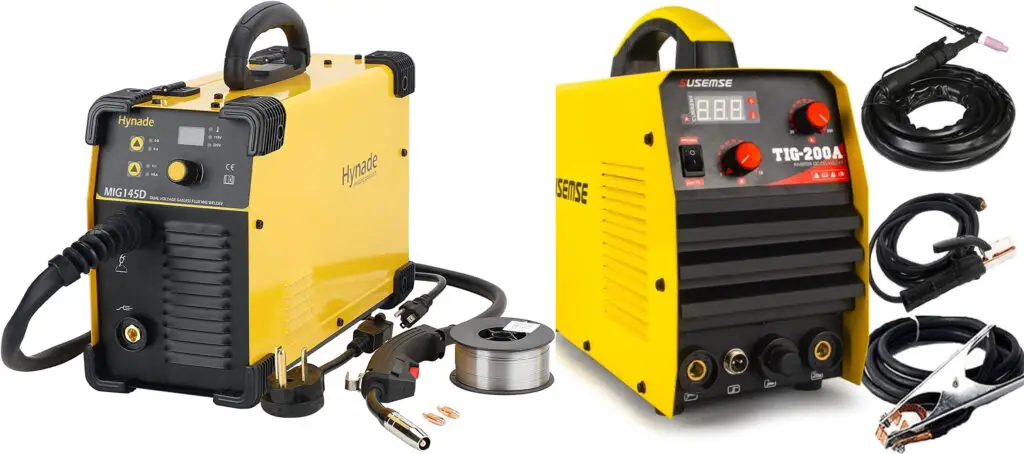Welding is a procedure where we make a strong connection between two pieces of metal using heat or pressure. And though there are other methods of metal attachment, like riveting, soldering, and brazing, welding is more widespread due to its versatility and feasibility.
Well, metal welding may be done in a variety of ways and heat can be utilised in a variety of methods to strengthen the two sections you’re joining, and a filler metal is often used to bond the parts efficiently. Some welding techniques rely on pressure, while others rely on both pressure and heat.
MIG and TIG welding are two of the most often employed welding technologies.
The fundamental distinction between MIG and TIG welding is the electrode that is used to generate the arc. An electric arc is formed between consumable wire electrodes and workpiece metals during the MIG welding process. Whereas in TIG welding, an electric arc is created between a non-consumable tungsten electrode and the workpiece metals.
Let us understand the difference between TIG and MIG through this table below:
| TIG | MIG |
| TIG stands for Tungsten Inert Gas Welding. But also known as Gas Tungsten Arc Welding (GTAW). | MIG stands for Metal Inert Gas Welding. It is also known as Gas Metal Arc Welding (GMAW), Metal Active Gas Welding (MAG). |
| In Tungsten Inert Gas (TIG) welding, there is use of an inert electrode so that it remains static and intact during the welding process. | In Metal Inert Gas (MIG) welding, there is use of a consumable electrode that is supplied into the welding zone constantly from a wire pool. |
| For welding, it employs a constant current welding power source. | For welding, it is most usually used with a constant voltage, direct current power supply. It may also employ alternating current and a continuous current system. |
| It is often used to weld stainless steels and nonferrous metals such as aluminium, magnesium, and copper alloys. | Aluminum, nonferrous metals, and steels are among the materials it can weld. |
| The TIG welding procedure necessitates the use of a highly competent operator. | The MIG welding procedure does not need a highly qualified operator. |
| Because of the short length, filler must be replaced on a regular basis. In TIG welding, this accidentally disrupts the welding process. | Because of its length, the filler electrode may be supplied for a longer period of time without being replaced in MIG. |
| The rate of filler deposition is modest. TIG is not particularly productive in this regard. | Because of the high rate of filler deposition, MIG is a very productive technique. |
| In some circumstances, filler metal from outside may be required if TIG is used. | There is no need for filler metal. In MIG, the feed electrode wire melts and functions as filler metal. |
| TIG welding can weld thin metal sheets as thin as 5 mm. | MIG welding can weld metal sheets as thick as 40 mm. |
| Because it allows for better control over the weld area, TIG creates high-quality welds. | When opposed to TIG, MIG generates a lower quality weld. |
| TIG welding produces very little spatter. | MIG welding typically results in splatter. This results in the waste of expensive filler metal. |
| TIG welding requires the employment of a welding torch, a non-consumable tungsten electrode, a constant-current welding power supply, and a shielding gas source. | A welding gun, a welding power supply, a feed wire unit, a welding electrode wire, and a shielding gas supply are all utilised in the MIG welding process. |
| TIG welding is a slower technique. | MIG welding is a speedier technique. |
| Can be welded in any position. | It will not function in any position. |
Pros and cons of TIG and MIG welding
TIG advantages
1.) Accuracy: TIG welds are more exact and have an overall better quality than MIG welds.
2.) No requirement for filler: TIG welding does not necessitate the use of filler material.
3.) Cleaner process: The TIG method is more environmentally friendly, and the finished product is more aesthetically pleasing.
4.) Less maintenance: The electrodes require less maintenance, although they must be cleaned between usage.
TIG disadvantages
1.) Cost: TIG welding costs more than MIG welding since it is a slower process with lower deposition rates.
2.) Greater difficulty: Because the welds are more complex to complete, TIG welding necessitates the use of a more skilled operator which needs good precision and experience.
3.) The necessity for a clean surface: Before beginning this process, the welding surface must be well cleaned.
4.) Extended time: This approach requires more time to prepare and the welding procedure is more time consuming.
MIG advantages
1.) Reduced time: MIG produces welds in a shorter period of time.
2.) Lower cost: This procedure is less expensive than TIG welding, and the requisite equipment is more readily available.
3.) Accuracy: MIG welding allows for more precise bonding.
4.) Cleaner process: This procedure yields a clean weld with less post-weld upkeep.
MIG disadvantages
1.) Weaker strength: MIG welding is often weaker than TIG welding.
2.) Dangers: MIG welding may create a lot of smoke and fumes, as well as sparks.
3.) Rust: This procedure may result in rust deposits.
4.) Required thickness: When working with thin materials, MIG welds have the ability to burn through the metal.
5.) Environmental constraints: Because of the gases involved, this procedure is difficult to employ outside.
Since we have seen enough differences between TIG and MIG welding techniques, now let us see some similarities between them.
TIG and MIG welding are both arc welding methods because an electric arc is formed between the electrode and the base plates to melt the metal surfaces and create the coalescence.
They are also classified as fusion welding methods since the base metals are fused during the connecting process.
In both circumstances, inert shielding gas is employed to protect the hot weld bead from oxidation and contamination.
For shielding purposes, only inert gases such as argon, helium, nitrogen, or a combination of such gases are used.
In both circumstances, shielding gas must be obtained from outside sources. Both procedures make use of bare electrodes. Although the electrode material is different in these two procedures, neither of them uses a flux-coated electrode.
Applications of TIG and MIG welding techniques
MIG
MIG method offers several advantages. That implies there will be occasions when MIG welding is the best option. A MIG welder might be useful in the following situations:
1.) Stock that is thicker- When welding thicker material, the rapid, productive MIG technique is a preferable option.
2.) Long Distance Runs- When there are a lot of lengthy runs, the MIG process can manage it because of its constantly supplied wire.
3.) Positions that are difficult- Because a MIG torch only requires one hand to operate, you have a free hand to steady yourself or hold components.
4.) Production- MIG simply can install more amounts of weld filler and make more feet of bead in an hour than TIG. MIG welding is the method of choice when great productivity is required.
5.) Welders with less experience- With the MIG method, welders with less expertise can lay excellent beads on a job. However, they might not be able to do so using a TIG welder.
TIG
TIG welding is a preferable option when dealing with the following situation:
1.) Material that is thin- TIG welding’s accuracy and precision make it ideal for thin material that is prone to warping and burn throughs.
2.) Nonferrous metals- TIG welding is frequently the first choice for skilled welders when working with metals such as aluminum, stainless steel, copper, and other exotic metals.
3.) Work that is fine or delicate- As we know that TIG welding creates aesthetically pleasing welds. TIG uses that are extremely visible include artwork, car restoration, sinks, and so forth.
4.) Welders with prior experience- TIG welding is more difficult to master, but if you have the experience, you may use TIG welds when it is the superior welding procedure.
5.) Short Distance Runs- TIG welding is best suited for short lines, such as pipe junctions.
Conclusion
One welding technique is not better than the other. However, depending on the factors you must handle, one may be a superior choice in certain cases.
MIG welding produces low-cost, high-speed welds on steel and aluminum, and MIG welding is a superb alternative for low-cost and high-production.
Whereas, TIG welders produce precise, thin, attractive beads with good penetration. However, they are more costly and need the use of skilled welders.








